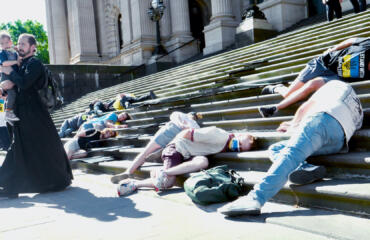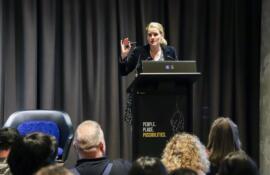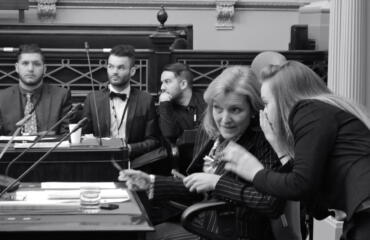
The deluge comes as the party seeks to develop answers to explosive issues like refugee policy in a bid to capture votes from both inner-city dwellers and suburbanites. The party remains deeply riven over refugees, and a panoply of proposals around the issue could come into play.

Momentum to find solutions is strong in the afterglow of the party’s win in the Batman by-election, which leaders see as a sign that Labor can claw back ground lost to the Greens. Key figures and powerbrokers are seeking to get their own agendas up as they grow more optimistic around their chances in the next federal election.
A big ACTU push to “change the rules” around work rights, and broad concerns about inequality, are set to dominate the conference agenda.

“It is critical this conference generates a platform ready for a great Labor victory,” declares Right-aligned Victorian state minister John Eren in his email pitch to get elected as a conference delegate.

The triennial conference also marks a big moment for rank and file members. For the first time, they will have the power to directly elect many of the delegates to the conference.
While the conference has traditionally been dominated by the party’s Right faction, the last conference was evenly divided. This time, there is the possibility the Left faction could have a majority grip on the numbers on conference floor for the first time since the 1970s.

The conference represents Labor’s members, but there’s no guarantee the parliamentary caucus won’t pull in a somewhat different direction. Nonetheless, a Left majority at conference could pull the party’s formal positions significantly to the left.
Forty-three Victorian delegates will be directly elected by state party members, with ballot papers due back yesterday (May 4).

Members’ inboxes have been flooded with pitches from delegate hopefuls looking for votes – with candidates ranging from powerful MPs to rank and file members.
The Battleground
Now comes an epic battle for the national presidency between two party heavyweights, with voting opening yesterday.
Federal shadow minister Mark Butler, from the party’s Left, is seeking re-election. But he is being challenged by Wayne Swan, the Right-aligned former Deputy Prime Minister and Treasurer.

“I’m committed to fighting inequality and ensuring that we win the battle of ideas with the radical right that have taken over the Liberal Party,” declares Swan.
“Labor is at its best when it combines big, bold ideas with mass mobilisation … our party is getting smaller, and you can’t get stronger when you’re getting smaller,” says Butler.

The increased attention to both the presidential and party conference elections represents a push by the party to boost community engagement.
In March, the party decided to start formally backing candidates in local government elections, following heavy losses to the Greens in the inner city in recent years. The party hopes that strategic engagement in key councils will help renew the party’s grassroots.

Both presidential hopefuls and a variety of delegate hopefuls are talking the talk on party engagement. But there is also a recognition that getting organised isn’t enough.
While the Batman win, credited in part to strong organisation, buoyed the party, there’s also recognition that the candidate and the messaging were crucial in winning that contest.
The party is furiously looking for more Ged Kearneys, and more ways to successfully thread the needle between left and right. The conference could mark a turning point on some areas.
Immigration remains a big challenge. Labor embracing offshore detention and boat turnbacks partly neutralised the issue with suburbanites in the last election campaign, but proved toxic with its previous inner city base.
While the Right faction was behind Labor’s shift on immigration, a new generation of Right-aligned delegate candidates claim they are trying to find a new balance. “We need to balance the reality of the current worldwide refugee crisis with a humane system of processing refugees,” says Dimity Paul, a candidate linked to the “SDA” Right sub-faction.
Bassel Tallal’s family came from Syria in the late 2000s. He is now a young lieutenant of former Senator Stephen Conroy and his “Cons” sub-faction in the Right.
Tallal is calling for the conference and the party to embrace a new program of community sponsorship of refugees. “Now is the time for Labor to redefine a new approach to resettlement,” he says.
Large parts of the Left, including associated delegate candidates, remain steadfastly opposed to the direction the party has taken.
“Despite pressure from the leadership of our party, I voted against turning back asylum seeker boats, which I believe is inhumane and ineffective,” says Lee Tarlamis, a Left-aligned former state upper house MP.
The other area of party upheaval many candidates are pushing is around workplace relations. And Labor leader Bill Shorten seems sympathetic to parts of the push.
Labor rode to victory in 2007 off the back of its anti-WorkChoices campaign. The post-WorkChoices laws it drew up were largely accepted by the Coalition, which has been gun-shy of another electoral backlash.
But unions have complained over the years that the laws are insufficient and are being undermined by the current government. They’re calling to “change the rules”, with backing of parts of Labor.
“The current rules are giving big business a free ride, while working people pay the price of running the nation,” says Tanja Kovac, an Industrial Left candidate and women’s advocate in and outside the party.
Likewise, Stephanie Perri, a former federal candidate aligned to the “NUW” Right sub-faction, is calling for “real industrial relations reform, and the restoration of penalty rates”.
The Victorian party faces its first electoral test in November’s state election.
Meanwhile, the Liberals are aggressively targeting suburban and regional seats, while the Greens are still hoping to wipe out Labor in most of the inner city.
After that, the party pivots to the federal election that seems within grasp – but it needs to get its settings right, internally and with voters.
“Despite the Liberals’ current troubles, and our position in the polls, we have a challenge ahead of us,” cautions party elder and powerbroker Senator Kim Carr.



